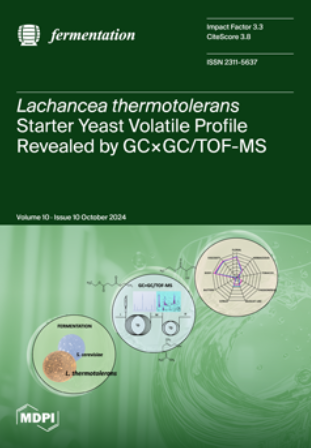Prevalence of Lentilacobacillus hilgardii over Lactiplantibacillus plantarum in Low-Temperature Spontaneous Malolactic Fermentation of a Patagonian Pinot Noir
IF 3.3
3区 农林科学
Q2 BIOTECHNOLOGY & APPLIED MICROBIOLOGY
引用次数: 0
Abstract
The spontaneous malolactic fermentation (MLF) in a centenary winery from Patagonia, Argentina, is conducted by predominantly mesophilic Oenococcus oeni and Lactiplantibacillus plantarum. In this region, MLF takes place from 14 to 4 °C, leading to heat cellars incurring in higher costs and non-sustainable practices. Previously, psychrotrophic strains of O. oeni had been obtained from a Patagonian wine. The goal of this work was to identify the Lactobacillaceae microbiota related to low-temperature MLF and assess their contribution. Nine sychrotrophicc Lentilactibacillus hilgardii strains were identified by sequencing the 16S rRNA gene, and the strains typified by RAPD-PCR. All strains consumed L-malic acid at 4 and 10 °C in sterile wine. The selected UNQLh1.1 strain revealed implantation capacity and L-malic acid consumption at 4 and 10 °C in the presence of the native microbial consortium. Furthermore, the histidine decarboxylase (hdc) gene was not detected in any of the Len. hilgardii strains. The prevalence of Len. hilgardii under low-temperature conditions represents a novelty compared to previous findings of LAB diversity in the MLF of Patagonian wines. The native Patagonian psychrotrophic Len. hilgardii strains are a new player in fermentations conducted at low temperatures with the potential to be used as a sustainable MLF starter.在巴塔哥尼亚黑皮诺低温自发苹果酸乳酸发酵中,希尔加德小杆菌比植物乳杆菌更占优势
阿根廷巴塔哥尼亚一家百年酿酒厂的自发苹果酸-乳酸发酵(MLF)主要由嗜中温的葡萄球菌和植物乳酸杆菌进行。在该地区,MLF发生在14至4°C的温度下,导致酒窖成本更高,且不可持续。此前,从巴塔哥尼亚的一种葡萄酒中获得了具有嗜冷性的O.oeni菌株。这项工作的目的是鉴定与低温MLF相关的乳酸杆菌科微生物群,并评估它们的贡献。通过16S rRNA基因测序,鉴定出9株精神营养型希尔加第慢杆菌,并以RAPD-PCR为代表。所有菌株在4和10°C的无菌葡萄酒中消耗L-苹果酸。选定的UNQLh1.1菌株显示了在天然微生物群落存在的情况下,在4°C和10°C下的植入能力和L-苹果酸消耗量。此外,在任何Len中都没有检测到组氨酸脱羧酶(hdc)基因。hilgardii菌株。Len。与巴塔哥尼亚葡萄酒MLF中LAB多样性的先前发现相比,低温条件下的hilgardii代表了一种新颖性。土生土长的巴塔哥尼亚精神病患者Len。hilgardii菌株是低温发酵中的一个新参与者,有潜力用作可持续的MLF发酵剂。
本文章由计算机程序翻译,如有差异,请以英文原文为准。
求助全文
约1分钟内获得全文
求助全文
来源期刊

Fermentation-Basel
BIOTECHNOLOGY & APPLIED MICROBIOLOGY-
CiteScore
3.80
自引率
18.90%
发文量
594
审稿时长
7 weeks
期刊介绍:
Fermentation-Basel is an international open access journal published by MDPI, focusing on fermentation-related research, including new and emerging products, processes and technologies, such as biopharmaceuticals and biotech drugs. The journal enjoys a good reputation in the academic community and provides a high-impact forum for researchers in the field of bioengineering and applied microbiology.
 求助内容:
求助内容: 应助结果提醒方式:
应助结果提醒方式:


